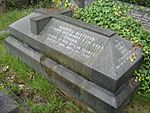Frederic Thesiger, 2nd Baron Chelmsford
This article needs additional citations for verification. (April 2011) |

General Frederic Augustus Thesiger, 2nd Baron Chelmsford GCB, GCVO, (31 May 1827 – 9 April 1905) was a British general.
Early life
Frederic Augustus Thesiger was born 31 May 1827, the son of Frederic Thesiger, a lawyer who later became Lord Chancellor and be created Baron Chelmsford. Thesiger was educated at Eton College.[1]
Career

He wished to pursue a military career, and after unsuccessfully trying to obtain a place in the Grenadier Guards, he was given a commission in the Rifle Brigade in 1844. In 1845, he served with the Rifles in Halifax, Nova Scotia before purchasing an exchange into the Grenadiers as Ensign and Lieutenant in November of that year. He was promoted Lieutenant and Captain in 1850, and became aide-de-camp to the Lord Lieutenant of Ireland, Lord Eglinton, in 1852, and then to the Commander-in-Chief in Ireland, Sir Edward Blakeney, from 1853 to 1854.
In May 1855, he left for the Crimean War, in which he served firstly with his battalion, then from July 1855 as aide-de-camp to the commander of the 2nd Division, Lieutenant-General Edwin Markham, and finally from November 1855 as deputy assistant quartermaster general on the staff at Headquarters, being promoted brevet Major. He was mentioned in despatches and received the fifth class of the Turkish Order of the Medjidie and the British, Turkish and Sardinian Crimean medals.
In 1857, he was promoted Captain and Lieutenant-Colonel, and transferred, as a Lieutenant-Colonel, to the 95th (Derbyshire) Regiment in 1858, serving with that regiment at the end of the Indian Mutiny, for which he was again mentioned in despatches. From 1861 to 1862 he served as deputy adjutant general to the forces in Bombay, and was promoted brevet Colonel in 1863. He served, again as deputy adjutant general, in the 1868 Expedition to Abyssinia, for which he was awarded the CB and made an aide-de-camp to Queen Victoria in 1868. He was adjutant general in the East Indies from 1869 to 1874.
He returned to England in 1874 as colonel on the staff, commanding the forces at Shorncliffe, and was appointed to command a brigade at Aldershot, with the temporary rank of Brigadier-General, in 1877.

He was promoted Major-General in March 1877. In February 1878 he was appointed to command the forces in South Africa, with the local rank of Lieutenant-General, and in October succeeded his father as 2nd Baron Chelmsford. He brought the Ninth Cape Frontier War to an end in July 1878, and was made a KCB in November.
In January 1879 he invaded Zululand (see Anglo-Zulu War), but the centre column of his forces was defeated at the Battle of Isandlwana. Because an invasion of Natal seemed likely as a result, Chelmsford was relieved of his command. However he defeated the Zulus at the Battle of Ulundi just before the arrival of his replacement, Sir Garnet Wolseley, which effectively ended the campaign. He left for England in July 1879, but Wolseley ensured in his despatches that Chelmsford receive all the credit for Ulundi, and he was awarded the GCB in August.
Lord Chelmsford became Lieutenant-General in 1882, Lieutenant of the Tower of London from 1884 until 1889, colonel of the 4th (West London) Rifle Volunteer Corps in 1887, full General in 1888, and colonel of the Derbyshire Regiment in 1889. He exchanged the colonelcy of the Derbyshires for that of the 2nd Life Guards in 1900, and was made GCVO in 1902.
He was the inaugural Governor and Commandant of the Church Lads' Brigade, a post he held until he died.
Family
His sister, Julia (1833–1904) was married to Sir John Eardley Wilmot Inglis (1814–1862)[2] who commanded the British forces during the Siege of Lucknow in 1857. She later wrote of her experiences during the siege including extracts from her diary.[3]
Death
In 1905, he suffered a seizure and died while playing billiards at the United Service Club. He is buried in Brompton Cemetery in London.
He left four sons, the eldest of whom succeeded as 3rd Baron Chelmsford and later became Viceroy of India and first Viscount Chelmsford. Another son was Lieutenant-Colonel Eric Thesiger who served in the First World War and was also a Page of Honour for Queen Victoria.
Notes
- ^ "Thesiger, FredericAugustus" (Subscription required). Oxford DNB. Retrieved 17 May 2011.
- ^ "Hon. Julia Selina Thesiger". thepeerage.com. 13 February 2011. Retrieved 16 April 2011.
- ^ Inglis, Julia Selina (1892). "The Siege of Lucknow: a Diary". A Celebration of Woman Writers. James R. Osgood, McIlvaine & Co.,. Retrieved 16 April 2011.
{{cite web}}: CS1 maint: extra punctuation (link)
- 1827 births
- 1905 deaths
- British Army personnel of the Crimean War
- British military personnel of the Indian Rebellion of 1857
- British military personnel of the 9th Cape Frontier War
- British military personnel of the Anglo-Zulu War
- British Army generals
- British Life Guards officers
- Barons in the Peerage of the United Kingdom
- Knights Grand Cross of the Royal Victorian Order
- Knights Grand Cross of the Order of the Bath
- Burials at Brompton Cemetery
- Rifle Brigade officers
- Grenadier Guards officers
- Sherwood Foresters officers
- Old Etonians
